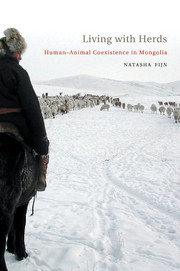Book contents
- Frontmatter
- Contents
- Lists of Plates, Figures, Maps, Tables, and Online Video Segments
- Glossary
- Acknowledgments
- LIVING WITH HERDS
- PART ONE CROSSING BOUNDARIES
- PART TWO THE SOCIAL HERD
- PART THREE LIVING WITH HERDS
- 7 IN THE LAND OF THE HORSE
- 8 THE CYCLE OF LIFE: BIRTH TO DEATH, SPRING TO WINTER
- 9 THE DOMESTIC AND THE WILD
- 10 THE SACRED ANIMAL
- CONCLUSION: CO-DOMESTIC LIVES
- Appendix
- References
- Index
- Plate section
7 - IN THE LAND OF THE HORSE
from PART THREE - LIVING WITH HERDS
Published online by Cambridge University Press: 03 May 2011
- Frontmatter
- Contents
- Lists of Plates, Figures, Maps, Tables, and Online Video Segments
- Glossary
- Acknowledgments
- LIVING WITH HERDS
- PART ONE CROSSING BOUNDARIES
- PART TWO THE SOCIAL HERD
- PART THREE LIVING WITH HERDS
- 7 IN THE LAND OF THE HORSE
- 8 THE CYCLE OF LIFE: BIRTH TO DEATH, SPRING TO WINTER
- 9 THE DOMESTIC AND THE WILD
- 10 THE SACRED ANIMAL
- CONCLUSION: CO-DOMESTIC LIVES
- Appendix
- References
- Index
- Plate section
Summary
The centrality of the horse to human existence on the central Eurasian steppe throughout the Holocene is reflected by its virtual omnipresence in the cultural and economic life of steppe peoples.
(Levine 2004: 115)For the Mongols, a man without a horse was a nobody; a man was virtually never seen in the countryside without his horse. Furthermore, a man was known by his horse. Mongols did not judge a man by his clothes or his accent. They looked carefully at his horse, and by its proportions, color, gait, and by the look in its eye they could tell all the essentials about its owner. Knowing this, people chose and educated their riding horses with almost unbelievable care.
(Waddington-Humphrey 1974: 485).INTRODUCTION
Mongolia is described in popular literature as “The Land of the Horse,” conjuring up an image of a nomadic herder galloping across the vast grassland steppe. The Hollywood ideal of the cowboy could easily be conceived of as descending from the myth of the nomad (Khazanov 1994). When in Mongolia, the dust-swept towns and the rugged-looking men riding in on horseback brings to mind the archetypal western scene. In this chapter I explore some of the ways in which the horse is of central cultural importance to Mongolian herders. The complex role of the horse is a fascinating aspect of Mongolian herding society, especially because the horse is both a utilitarian resource, as Mongolian herders eat horsemeat in winter, and a unifying symbol, expressed on Mongolian flags.
- Type
- Chapter
- Information
- Living with HerdsHuman-Animal Coexistence in Mongolia, pp. 151 - 174Publisher: Cambridge University PressPrint publication year: 2011

